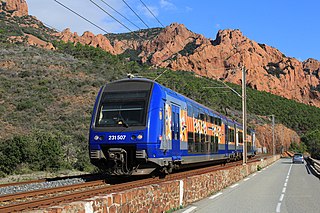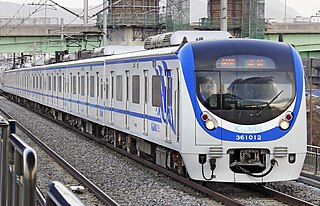
The British RailClass 411 (4CEP) electric multiple units were built at Eastleigh works from 1956–63 for the newly electrified main lines in Kent. These units, which used the British Railways Mark 1 bodyshell, were based on the earlier Southern Railway 4 COR design, built in 1937. Variants of the class 411 design included the class 410 and class 412 4 BEP units, which contained a buffet car in place of a standard trailer. They were later used on services in Sussex and Hampshire; following the privatisation of British Rail in 1995, the units were used by the Connex South Central, Connex South Eastern and South West Trains franchises. They were replaced by Juniper, Desiro, and Electrostar units. The fleet's lifespan was 49 years. These units are the longest-lived BR Mark 1 EMUs.

Seoul Subway Line 1 of the Seoul Metropolitan Subway is a rapid transit and commuter rail line which links central Seoul, South Korea to Yeoncheon in the northeast, Incheon in the southwest, and Sinchang via Suwon and Cheonan in the south. The central underground portion of Line 1, running underneath Sejongno, Jongno, and Wangsan-ro avenues along Seoul's traditional downtown area, is the oldest subway-operated section in the Seoul Metropolitan Subway system. Its branches and services cover a large part of the Seoul Capital Area; totaling 218.3 km (135.6 mi) in route length.

Seoul Subway Line 4 of the Seoul Metropolitan Subway is a long line crossing from the southwest to the northeast across the Seoul National Capital Area. The central section in Seoul City is operated by Seoul Metro with some trains offering through service to Korail's Ansan and Gwacheon Lines. The southern terminus (Oido) is in Jeongwang 4-dong, Siheung City, and the northern terminus (Jinjeop) is in Jinjeop-eup, Namyangju-si, Gyeonggi-do; the newly built northern section is correspondingly owned by a company owned by Namyangju-si, with operations contracted to Seoul Metro. In 2022, the Seoul Metro operated section had an annual ridership of 219,587,000 or about 601,608 passengers per day.

The Harris trains were the first steel-bodied electric multiple unit (EMU) trains to operate on the suburban railway network of Melbourne, Victoria, Australia. They were introduced in 1956, by the Victorian Railways, and last operated in 1988, although a number of the carriages were converted for other uses and are still operating. They were named after Norman Charles Harris, Chairman of Commissioners of the Victorian Railways, between 1940 and 1950.

The Kawasaki Heavy Industries & Nippon Sharyo (KNS) C751B was the third generation electric multiple unit rolling stock that operated on the North–South and East–West lines of Singapore's Mass Rapid Transit (MRT) system from 2000 to 2024, manufactured by Kawasaki Heavy Industries & Nippon Sharyo (KNS) under Contract 751B. 21 trainsets of 6 cars each were purchased at S$231 million, and it was the first rolling stock to feature VVVF insulated-gate bipolar transistor traction control system. Kawasaki manufactured 66 cars and Nippon Sharyo manufactured 60 cars respectively with no comparable differences, having been built to agreed specifications.

The MF 77 is a steel-wheeled variant of the rolling stock used on the Paris Métro. First used in 1978, it now runs on Lines 7, 8, and 13.

The MF 01 is a model of steel-wheeled electrical multiple units used on Paris's Metro system. The cars first arrived in December 2007 and delivery was completed in 2015. RATP ordered 160 trains or 800 cars in 2001, to replace the aging MF 67. It is used on Line 2, Line 5, and Line 9.

The TRTA/Tokyo Metro 05 series is an electric multiple unit (EMU) train type operated on the Tokyo Metro Tozai Line and Tokyo Metro Chiyoda Line Ayase Branch in Japan by the subway operator Tokyo Metro. Some sets have also been shipped to Indonesia, where they operate on the KRL Commuterline system in Jakarta.

The Class Z23500 also called TER 2N is a class of double-deck electric multiple units operated in France. They were built by GEC-Alstom and Ateliers du Nord de la France, for SNCF and are used on the TER Network. These sets consist of 2 double deck coaches. They were built from 1997 and a total of 80 units were built. The units were ordered by the following regions: Provence-Alpes-Côte d'Azur, Nord-Pas-de-Calais and Rhône-Alpes. They are mainly used on stopping services around the French Riviera, Lille (Nord-Pas-de-Calais) and Lyon (Rhône-Alpes). They use the TER livery of their regions, e. g. the trains of Rhône-Alpes have a light blue livery.

The Korail Class 1000 was a series of electric multiple units built in Seoul, South Korea, for Seoul Subway Line 1. The cars were built in and entered service between 1974 and 1997. They were gradually retired from the late 1990s to 2020 by newer electric multiple unit trains.

The Korail Class 311000 trains, some train of which were formerly identified as Korail Class 5000 trains, are commuter electric multiple units in South Korea used on Seoul Subway Line 1. Class 311000 trains were manufactured and delivered between 1996 and 2006, and again from 2012 to 2014 to expand service on the Gyeongbu Line and the Gyeongwon Line, and to replace older trains.

The Kawasaki Heavy Industries & CSR Qingdao Sifang C151B is the fifth generation electric multiple unit rolling stock in operation on the existing North–South (NSL) and East–West (EWL) lines of Singapore's Mass Rapid Transit (MRT) system, manufactured by Kawasaki Heavy Industries (KHI) & CRRC Qingdao Sifang under Contract 151B. 45 trains were purchased and all of them have been delivered to Singapore as of 12 April 2017. SMRT took delivery of the first 2 train cars on 21 May 2015. These trains increased frequency for the two MRT lines, North–South and East–West lines.

The Korail Class 321000 trains, created from an assortment of Class 5000, Class 6000, and new cars, are commuter electric multiple units in South Korea used on the Gyeongui-Jungang Line. Class 321000 trains were manufactured and delivered between 2006–2009 to provide service on what was known as the Jungang Line at the time, and to address progressing extensions starting from the extension to Paldang Station.

The Korail Class 331000 trains are commuter electric multiple units in South Korea used on the Gyeongui·Jungang Line. Class 331000 trains were manufactured and delivered in 2009 and from 2012 to 2014 to provide service on the Gyeongui Line and to address progressing extensions starting from the extension to Gongdeok Station.

The Korail Class 361000 trains are commuter electric multiple units in South Korea used on the Gyeongchun Line. Class 361000 trains were manufactured and delivered in 2010 to provide service on the Gyeongchun Line.

The Korail Class 371000 trains are commuter electric multiple units in South Korea used on the Gyeonggang Line.

The Korail Class 351000 trains, formerly identified as Korail Class 2000 trains, are commuter electric multiple units in South Korea used on Suin-Bundang Line. Class 351000 trains were manufactured and delivered between 1993.

The LRTA 2000 class is a class of electric multiple units in operation on the LRT Line 2, manufactured by Rotem and Toshiba.

The Suin–Bundang Line is a commuter rail service of the Seoul Metropolitan Subway system, operating on trackage from the Suin Line and the Bundang Line. Operation began on September 12, 2020.

The Seoul Metro 6000 series is a commuter train introduced by the Seoul Transportation Corporation from 1999 to 2000 with the opening of Seoul Subway Line 6. Currently, a total of 39 8-car trains are in operation on Line 6, and an additional 2 8-car trains are in operation on Line 7.






















